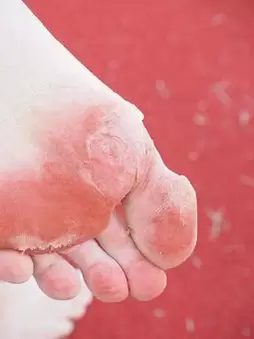Foot fungus is the most common fungal skin disease today. There are three main types of fungus of the foot, or fungus on the foot, as it is also called. And each is localized on different parts of the foot and looks different.

How can you get foot fungus?
Foot fungus is caused by a fungus that grows on or in the upper layer of the skin. Mushrooms thrive best in moist places. For example - in the area between the toes. Foot fungus spreads very easily. Just touching an infected person's finger or toe is enough to contract the disease with a high probability. But most commonly, fungal infections occur when people walk barefoot on contaminated surfaces near swimming pools or in the locker rooms of the same pool, gym, and other similar objects. Then the fungus can survive in your shoes, especially if the shoes are very narrow and air can't circulate around your feet.
If you touch an object with the fungus, then you can also become the one to distribute it and infect others. Furthermore, even if you infect others, this does not mean that you will definitely infect yourself. Doctors don't know why this happens, but everyone's predisposition to fungal infections of the feet is different. And if you already have a fungal infection of the scalp, there is a high chance you will get it again.
2. symptoms of fungus
Symptoms of athlete's foot can be burning and itching in the skin between the toes. The skin may peel and crack. Other symptoms of foot fungus can vary depending on the type of foot fungus diagnosed.
The first type is an infection that usually causes symptoms between the fourth and fifth toes. The skin becomes scaly, flaky, and cracked. In some cases, a bacterial infection can combine with a fungal disease and an even worse skin condition.
The second type of fungus is a disease that can begin with mild pain in the leg area. Then the skin on the heels or under the feet thickens and can crack. As foot fungus progresses, it also affects the nails. With onychomycosis, the nail can thicken, break, or even fall off. Fungal infections on the nails and skin of the feet need to be treated differently, as a rule.
Vesicle infections are the third type of tinea pedis. Usually, this foot fungus begins with fluid-filled blisters under the skin. Bubbles usually form on the bottom of the foot, but they can be found anywhere else on the foot. Concurrent bacterial infections can also develop with this foot fungus.
3. diagnosis of fungal diseases
As a rule, to diagnose foot fungus, the doctor only needs to examine the patient and study the medical history (symptoms, previous diseases). If the fungus on your feet is uncommon or doesn't respond to treatment, your doctor may take a sample of your skin or fingernails to test for fungus.
Not all foot problems are tinea versicolor, also known as athlete's foot. If you suspect you have thrush but have never had it, you should see a good dermatologist.
4. disease treatment
To treat foot fungus, there are usually enough special lotions, creams or sprays. In severe cases, your doctor may prescribe medication or topical medication to treat toenail fungus. It is necessary to treat the fungus as prescribed by the doctor. This will be a guarantee that it can indeed cure the fungus completely. In addition to treating athlete's foot in general, it's also important that feet are clean and dry. Mushrooms need warm and humid places to grow.
To prevent fungal infections and the re-occurrence of foot fungus, you should use your own specialized shoes when going to the gym, swimming pool and the like. To keep your feet dry, you can use talcum powder or special treatment products. Slippers or shoes that are not too tight will provide adequate air circulation and dehumidification.


























